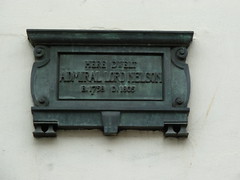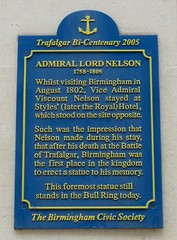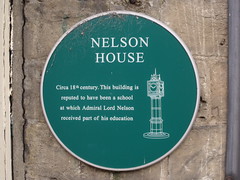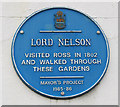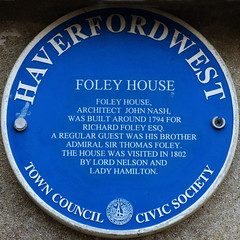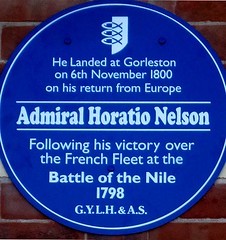Admiral Viscount Sir Horatio Nelson RN KB


Admiral Viscount Sir Horatio Nelson RN KB
(1758-1805)
Royal Navy Admiral, Knight Companion of the Order of the Bath, Duke of Bronté, 1st Baron Nelson (1798-1801), and 1st Viscount Nelson (from 1801)
Family tree
stepfather of Josiah Nisbet
Commemorated on 21 plaques
Horatio, Lord Nelson 1758-1805 lived here in 1798
103 New Bond Street, Westminster, W1, London, United Kingdom where they lived
Horatio Nelson lived here in 1797. Born 1758, fell at Trafalgar 1805.
147 New Bond Street, London, United Kingdom where they lived
Here dwelt Admiral Lord Nelson B.1758 D.1805
2 Pierrepont Street, Bath, United Kingdom where they lived
The Cricket Green Opposite this clubhouse is the Cricket or Lower Green, part of the common or grazing land of medieval times which largely escaped enclosure in the 18th and 19th centuries. Cricket has been played there for at least 250 years. Lord Nelson was once a spectator.
Mitcham Cricket Club, Cricket Green CR4 4LA, London, United Kingdom where they spectator
Trafalgar Bi-Centenary 2005 Admiral Lord Nelson 1758-1805 Whilst visiting Birmingham in August 1802, Vice Admiral Viscount Nelson stayed at the Styles' (later the Royal) Hotel, which stood on the site opposite. Such was the impression that Nelson made during his stay, that after his death at the Battle of Trafalgar, Birmingham was the first place in the kingdom to erect a statue in his memory. This foremost statue still stands in the Bull Ring today.
Temple Row, Birmingham, United Kingdom where they stayed
Nelson House Circa 18th century. This building is reputed to have been a school at which Admiral Lord Nelson received part of his education
Reeds Homestore - 17 Bridge Street, Downham Market, United Kingdom where they received part of his education
Merton Place. Sixty metres (200 feet) to the south east was ‘Merton Place’, the only house ever owned (1801 – 1805) by Admiral Lord Nelson and from which he set out for the Battle of trafalgar. Lady Hamilton also lived here 1801 – 1808.
Merton Place, nr Doel Close, Merton, London, United Kingdom where they owned a house and lived
Vice Admiral Lord Horatio Nelson On 21 May 1776 Horatio Nelson, then a midshipman being invalided back to England from the East Indies, arrived in Simon's Bay aboard the H.M.S. Dolphin. The ship remained here for a month and it is probable that Nelson did come ashore during this period.
St George's Street, Simon's Town, South Africa where they was
The Birthplace of Admiral Lord Nelson The Old Rectory in which the Admiral was born stood twenty yards back from this wall. It was pulled down in 1803
?, Burnham Thorpe, United Kingdom where they was born (1758)
Lord Nelson visited Ross in 1802 and walked through these gardens.
Merton House Hotel, Edde Street, Ross-on-Wye, United Kingdom where they visited (1801)
Here Nelson fell 21st Oct 1805
Quarter Deck, HMS Victory, Portsmouth, United Kingdom where they fell (1805)
On Saturday 14th. September 1805, Admiral Lord Nelson boarded HMS Victory lying anchor off St. Helens near to this spot. HMS Victory with HMS Euryalus in company, sailed the following morning, Sunday 15th. September, to join the Fleet off Cadiz prior to the Battle of Trafalgar. 21st. October 1805.
?, St. Helens, Isle of Wight , United Kingdom where they was near
East Rock House. Admiral Lord Nelson, Sir William and Lady Hamilton stayed here in 1802
St Julian Street, Tenby, United Kingdom where they stayed (1801)
Site of The Blue Ball Inn. Admiral Lord Nelson with Sir William and Lady Hamilton in 1802 attended a performance in its 'Fit Up' theatre.
10 Upper Frog Street, Tenby, United Kingdom where they visited (1802)
Foley House. Foley House, Architect John Nash, was built around 1794 for Richard Foley Esq. A regular guest was his brother Admiral Sir Thomas Foley. The house was visited in 1802 by Lord Nelson and Lady Hamilton.
Goat Street, Haverfordwest, United Kingdom where they visited (1802)
City Arms. Site of North Gate of Saxon Town. Formerly the Town House of the Duke of Norfolk, this became the City Arms Hotel and Nelson stayed here 23rd August 1802
Barclays Bank - Broad Street, Hereford, United Kingdom where they stayed (1802)
In this house, then "The Three Cranes" Horatio Nelson and party stayed 17-18th August, 1802
Beaufort Square, Chepstow, United Kingdom where they stayed
Lady Emma Hamilton and Lord Horatio Nelson stayed here in 1801
The Royal Hotel, Beach Street, Deal, United Kingdom where they visited (1801)
He landed at Gorleston on 6th November 1800 on his return from Europe Admiral Horatio Nelson following his victory over the French Fleet at the Battle of the Nile 1798 G.Y.L.H & A.S.
Harbour's Mouth, Gorleston-on-Sea , Great Yarmouth, United Kingdom where they was
Some Facts of Interest in the History of the Old Church The Church was built to replace the former Church of St John at Tyburn 1400 Francis Bacon was married here 1606 William Hogarth portrayed the interior of the Church 1735 James Gibbs Architect, pupil of Wren was buried here 1754 Richard Brinsley Sheridan married Miss Linley here 1773 Charles Wesley brother of John Wesley was buried here 1788 Lord Byron was baptized here 1788 Lord Nelson worshipped here and Horatia his only child was baptized here 1803
Garden of Rest, Marylebone High Street, London, United Kingdom where they was
Safodd cafarn coets fawr yma yn yr 18fed ganrif, wedi ei henwi ar ôl Dugiaid Beaufort, perchenogion llawer o'r tir oddi amgylch. Yma, yn 1802, arhosodd yr Arglwydd Nelson a Syr William a'r Fonhesig Hamilton, wedi iddynt deithio i Drefynwy ar hyd yr Afon Gwy.
English translation: The Beaufort Arms was an 18th century coaching inn, named after the Dukes of Beaufort, whose lands these once were. Admiral Lord Nelson stayed here in July 1802, with Sir William and Lady Emma Hamilton, arriving by boat on the River Wye.
The Beaufort Arms Hotel, Agincourt Square, Monmouth, United Kingdom where they was



